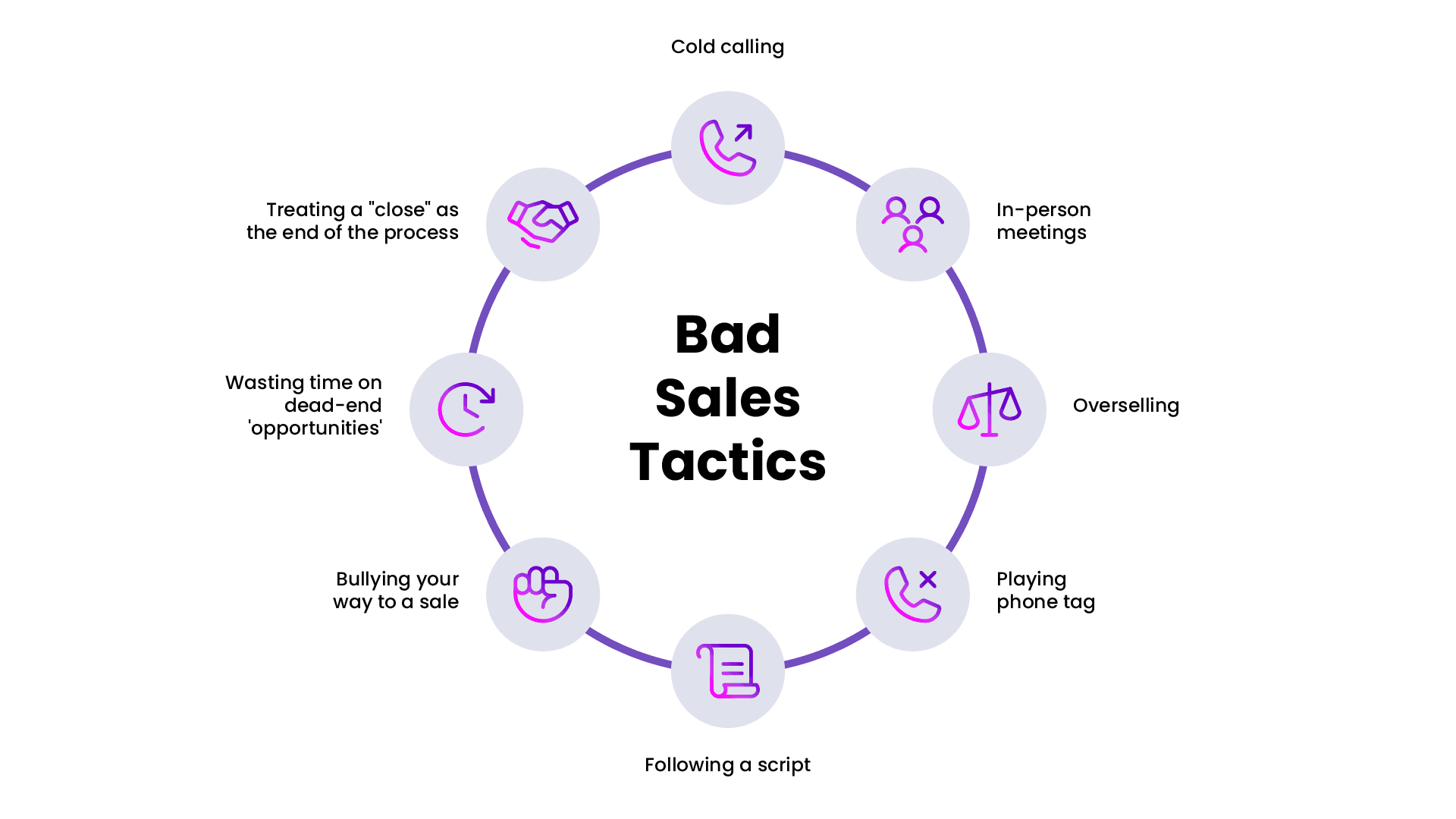Nov 16, 2022
8 Examples of Bad Sales Tactics To Avoid
COVID-19 changed the way business is done. We share eight bad sales tactics and outdated sales techniques to avoid when conducting business.

If you think your sales team dealt with enough changes during the 2020 pandemic, be prepared to deal with more changes in the post-COVID world.
The pandemic forced B2B buyers and sellers to adapt to the digital-first model to stay afloat. A McKinsey study shares that B2B buyers are now more comfortable making large new purchases and reorders online — 70% of B2B decision makers say they’re open to making new, fully self-serve, or remote purchases greater than $50,000.
They've found that online and remote selling is as effective as in-person engagement and that digital prospecting is as effective as in-person meetings to connect with existing customers, which is why man companies build a website.
Gone are the days when businesses relied solely on in-person meetings and cold calls. More businesses are adopting modern sales techniques, leveraging digital tools like sales automation, marketing automation, live chat, and video conferencing to improve the B2B sales experience.
In this article, we cover outdated selling techniques and bad sales tactics so you know what to avoid moving forward.
Bad Sales Tactics
Yep, bad is a fitting word to describe them. Let’s explore why and what you should do instead of using these tactics.
1. Cold Calling
Businesses once considered cold calling an essential part of a company’s sales strategy. But given the effort required and its low close rate (2% on average), you can consider it an outdated sales technique.
Here are a few reasons why:
It irritates customers: Three out of four millennials and Gen-Z customers avoid phone calls because they find them time-consuming and disruptive. They may not be your target audience, nor do they comprise the majority of the workforce right now — millennials and Gen-Zs currently make up 38% of the global workforce — but they will likely be your future customers. Millennials and Gen-Zs will comprise 58% of the workforce by 2030.
Damages company reputation: If customers find your sales practices annoying, best believe they’ll let others know. Whether by word of mouth or social media, it’s never been easier to let others know of companies with troublesome practices. One out of four people share they will completely avoid a brand if their friend or family tells a negative story about their experience.
Too much effort for too little reward: Sales calls have a 2% average close rate. Imagine putting in the effort to determine your customer needs to only receive responses from two out of 100 calls. How many deals do you think you’ll close?
What to do instead: Inbound Marketing
With inbound marketing, you attract potential customers by creating valuable content that speaks to their pain points. By establishing yourself as a thought leader, new customers will come looking for you when they're ready to buy.
2. In-Person Meetings
Setting in-person meetings without knowing the other party’s needs is another outdated sales technique.
These meetings require preparation and travel, often taking longer than the actual meeting itself. It’s a waste of resources — especially if the main agenda is to conduct a needs analysis (or determine whether the client is a fit).
What to do instead: Digital meetings.
With today’s digital technologies, you can leverage inside sales or the process of selling remotely via digital channels (e.g., phone and email) to have sales conversations with potential clients.
Communication apps and video conferencing technology like Zoom or Google Meet allow sales professionals to conduct business remotely, saving time, money, and energy that would otherwise be used on travel and preparation.
3. Overselling
In the earlier days, the only time salespersons would be able to get new business was by visiting prospective customers in person. They had a short window of time frame to convince decision-makers to purchase, so they could be creative about their sales pitch. Customers wouldn't remember what they said in the next few months, so sales reps were free to add and omit.
Overselling is another bad sales tactic because it ruins your business’ reputation and breaks customer trust. Sales teams nowadays speak with customers more frequently, so if you overpromise and underdeliver, you’ll get caught and lose customer trust.
According to 75% of executives, they've had a harder time building and maintaining trust since the pandemic began. When you lose customer trust, customer relationships start to crumble. And when they do, you’ll have difficulty getting repeat customers.
What to do instead: if you want to get customers, be honest about the limitations of your product. People appreciate it when you're upfront so that they can weigh the pros and cons during decision-making.
4. Playing Phone Tag
Research revealed that 42% of people would be encouraged to purchase if the sales rep called back at an agreed-upon, specified time.
The problem with scheduling meetings is the unnecessary back-and-forth to come up with a common time. Not only is it troublesome, but if you drag out scheduling too long, the customer could lose interest.
What to do instead: Automated meeting schedulers make it easy for both parties to determine a common time. There are a lot of free solutions, like the one included in HubSpot's CRM. Make connects with HubSpot’s CRM to access thousands of apps that automate your sales workflows.
5. Giving All Customers the Same Treatment
The sales process is not one-size-fits-all.
Thinking all your prospects are the same and forcing them through the same sales process is another bad sales tactic.
Customers have different timelines: some are ready to convert halfway through the sales process, while others take longer to convince and need to talk to more people.
By treating all customers the same, a lot of them won't feel heard. For example, if you're on a sales call and the customer expresses a need that isn't on your script, yet you continue to follow it, the customer will feel their need isn't being met.
What to do instead: Listen to the customer. According to HubSpot research, listening to the customers’ needs is the top way to create a positive sales experience.
Have a real conversation to gauge their pain points so you can recommend a solution that best suits their specific needs.
6. Bullying Your Way to a Sale
Some salespeople use high-pressure sales tactics to make a sale and meet their quotas. These bad sales tactics create negative impressions and don’t work. If they do, they don't usually generate repeat customers.
The best sales reps know that it’s not about the quota; it’s about solving the customers’ problems. If it seems like the customer is hesitant to close the deal, there might be an underlying reason that you can uncover.
What to do instead:
Learn to read the room.If a customer doesn’t look like they're interested in buying now, they might come back sometime in the future. Conduct sales training in communication to gauge customers’ non-verbal cues.
Give the customer time to come to a decision on their own. Don't build bridges or force connections just because you need to make a sale. You may make a sale now, but if the prospect isn't happy, they could tell their friends, which could pose a long-term problem.
Try Negative Reverse Selling. If the prospect keeps ghosting your meetings, ask them upfront whether the deal is a priority or not. Whether the response is positive or not, the outcome lets you know what to do moving forward.
7. Wasting Time on Dead-End “Opportunities”
Just like cold calling and taking in-person meetings, pursuing dead-end opportunities is a waste of resources.
The reality is you can't cater to all markets.At least 50% of your prospects aren’t a good fit for what you sell, so better focus your energy on those with a clear need for your product.
When you pursue dead-end opportunities, you create a needy reputation for your business, lowering product value in the customers' eyes.
What to do instead: Politely walk away and leave the door open. Customers will approach you when they're ready.
8. Treating a "Close" as the End of the Process
Most sales teams think closing a deal is the end of the sales process, but that’s not the case, as customers often need after-sales support.
After-sales care enhances customer satisfaction, improves customer relationships, and deepens customer loyalty, leading to referrals, increased sales, and a higher retention rate.
What to do instead: Follow up to see how the customer is doing with the product. Offer support should they need it.
Final Thoughts: Examples of Bad Sales Tactics To Avoid
As we move into a post-pandemic world, we’re seeing more businesses embrace automation tools like Make and HubSpot to streamline their workflows, rendering old sales techniques like cold-calling and in-person meetings obsolete.




